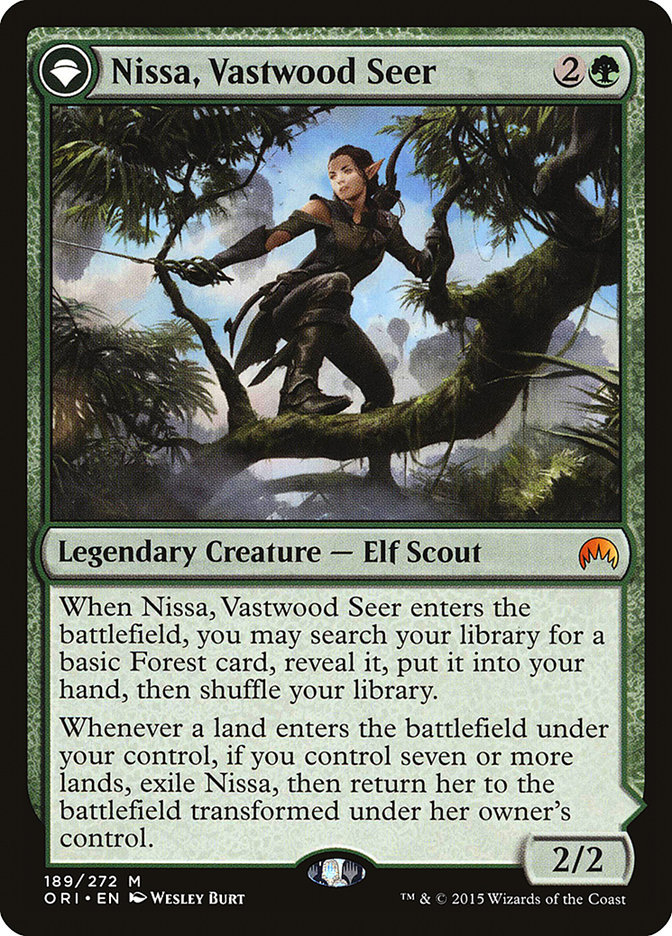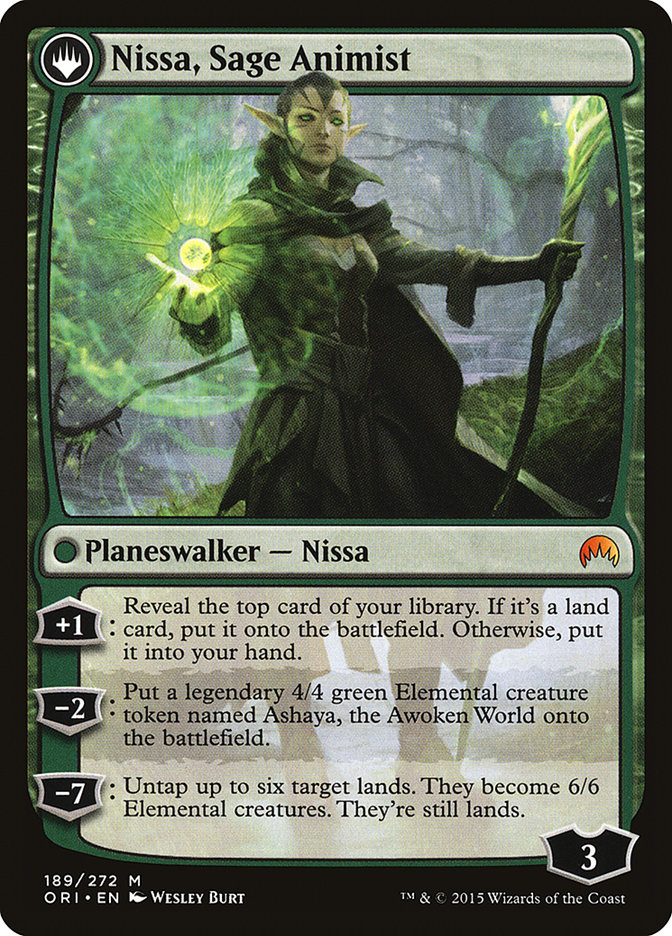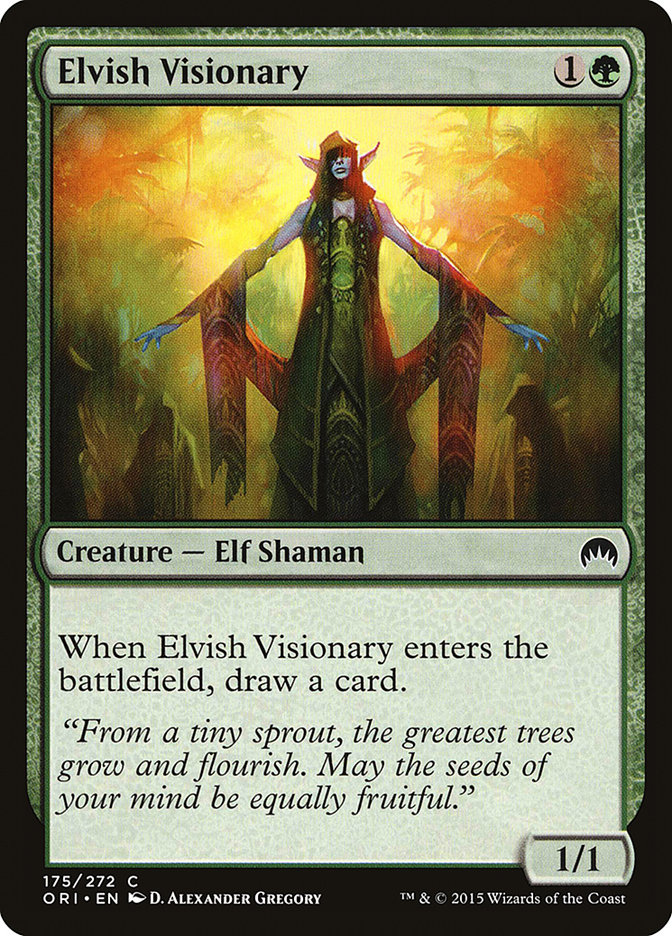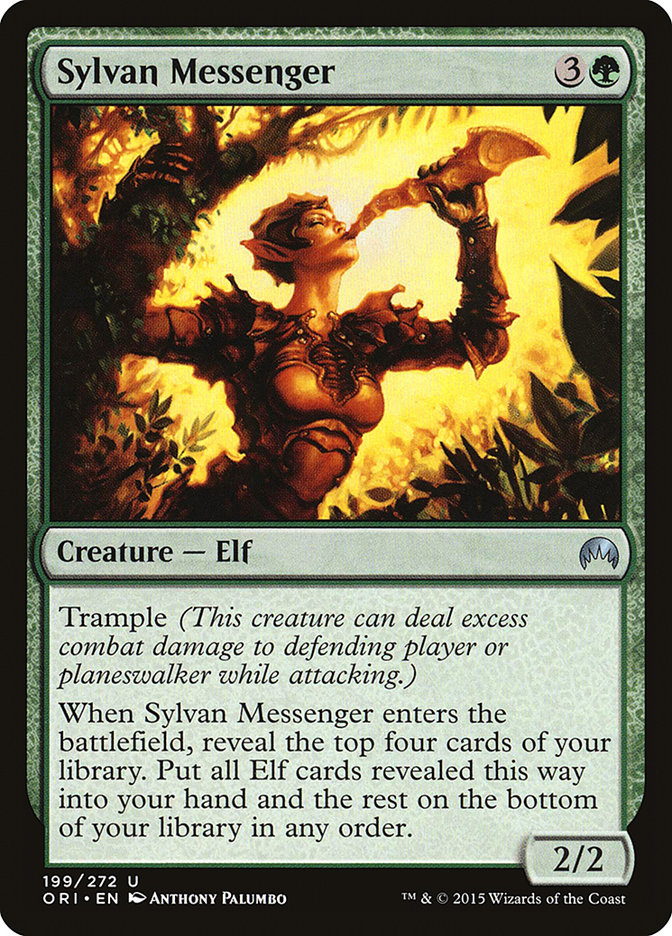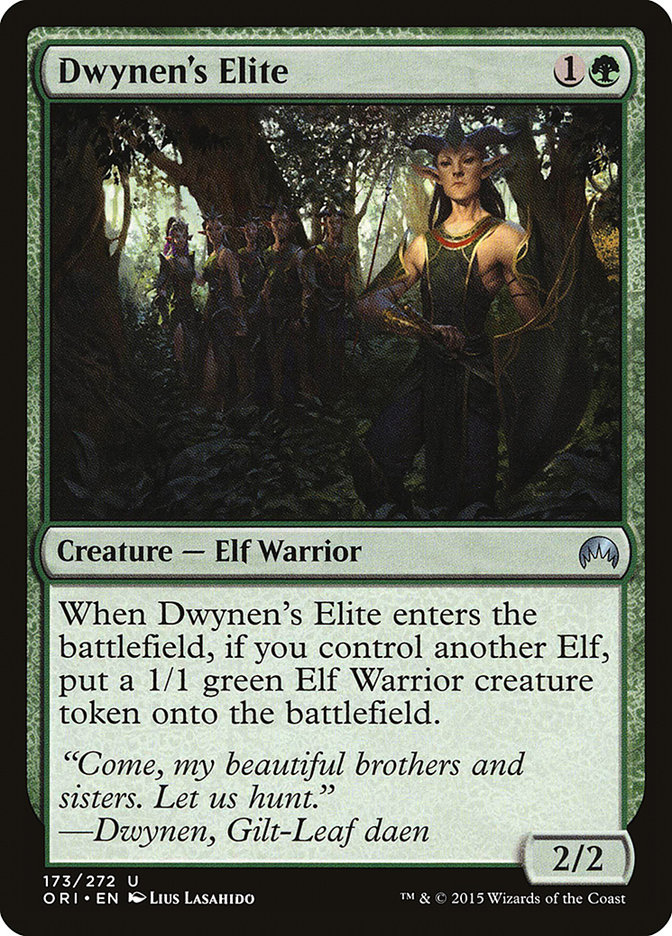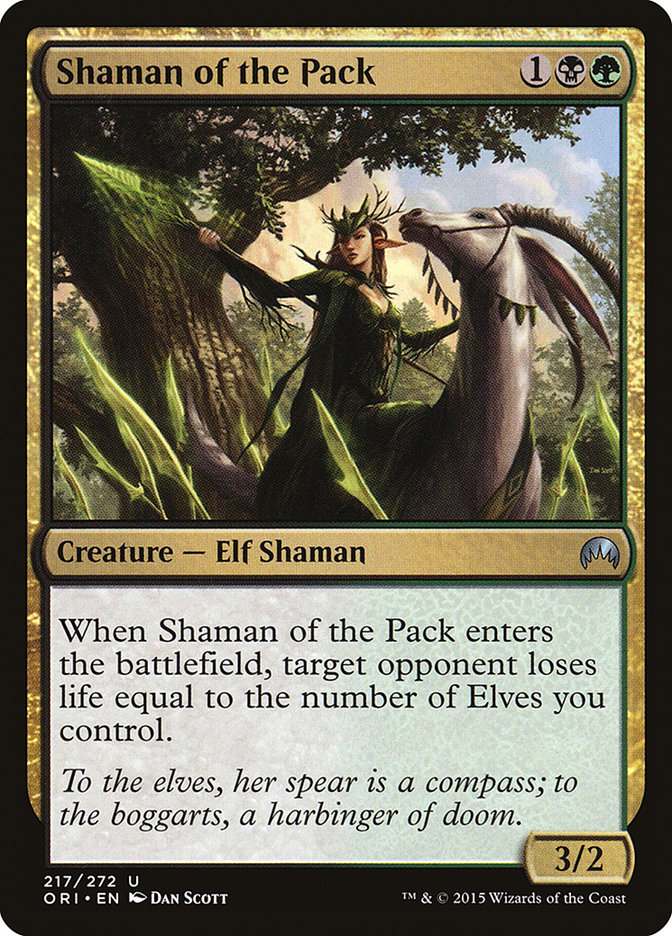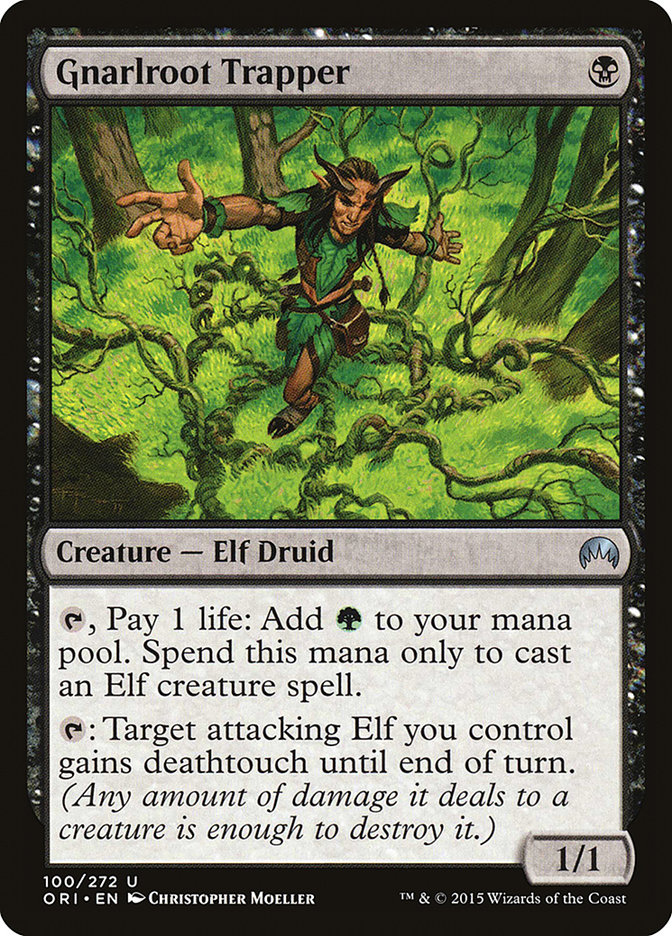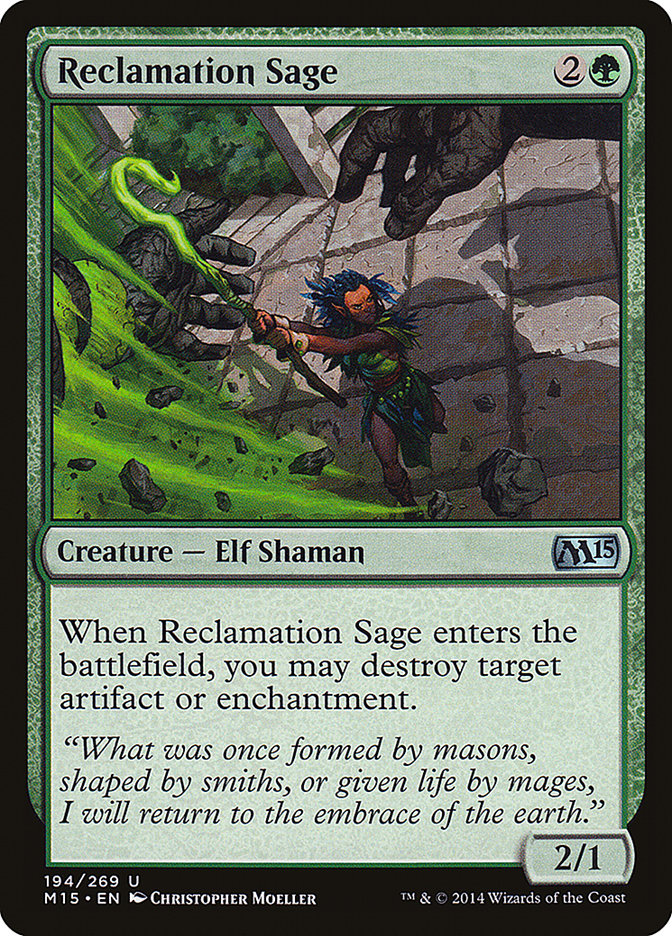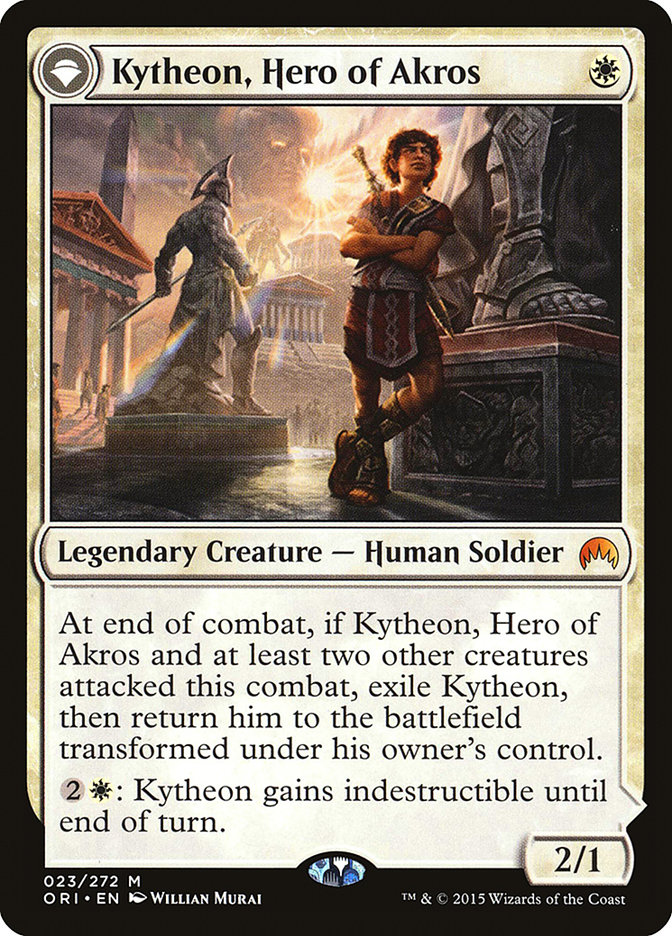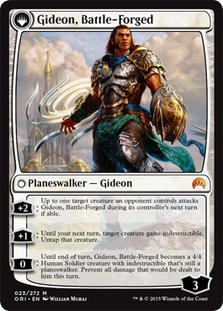Today, I’d like to focus on what will surely prove one of the most powerful cards in Magic Origins, Nissa, Vastwood Seer. While a lot of people have noted that she looks solid, I think she has been grossly underestimated because of how difficult it is to fully appreciate opportunity cost.
Clocking in at a new record 122 words, this is the most complicated Borderland Ranger ever conceived. However, the reason I think she is going to prove one of the strongest cards in the set and possibly format is related to what makes Deathrite Shaman, Figure of Destiny, Snapcaster Mage, and Den Protector so good. She’s a great early-game play, but you’re basically paying zero for some fantastic late-game punch.
To start with, though, let’s look at her like a Borderland Ranger. If Borderland Ranger was legal, I think it would at least be worth considering. There are a lot of good three-drops to compete with, but it is a good time for creatures you can play early that draw a card.
Nissa has two big drawbacks compared to Borderland Ranger. First, she only finds basic Forests, which is a pretty big limitation. Beyond that, she’s a legend, which doesn’t matter a ton, but it is something. If Nissa was just a legendary Borderland Ranger that only found Forests, she would already be worth considering in some decks, and not just because she (like the original Civic Wayfinder) is an Elf, although that helps.
What makes Nissa so amazing is that, early in the game, a cheap creature that draws you an extra land is exactly what you want. However, in the middle and late game, she’s also a great draw. Not only is she a two-for-one, she needs to be dealt with or else she will flip into a powerful planeswalker in the not-too-distant future.
As a late-game topdeck, she’s fantastic since she can just flip immediately. Just go find a Forest, play it as your seventh land, and when Nissa flips you’ve got two great options for how to use her immediately. I kind of imagine the default is to make a legendary 4/4. This leaves you with a 4/4, a Forest, and a planeswalker in play that will draw a card every turn. That’s a ton of value for just three mana, but the fact that your early cantrip creature did this is just insanity.
Alternatively, you can just tick the Sage Animist up, which is still a 3-for-1, but now the crazy planeswalker you are left with is at four loyalty, protecting it from some burn spells while threatening an ultimate in four turns that will usually end the game on the spot.
How good is Nissa’s backside? Well, I think we’d consider a planeswalker with that same text at 3GG. After all, its top ability is comparable to Sarkhan Unbroken’s. The -2 ability makes a 4/4 legend, instead of a 4/4 flying Dragon, which is somewhat worse. She also starts with three loyalty instead of four, which is a big deal. However, she is mono-color, which is nice. Of course, she doesn’t cost five. She costs just three, and in fact, in many spots, she functionally costs two since she gets you a mana towards your next play.
Getting a planeswalker that would be godly at four mana, and fringe playable at five mana, at a discount is nice and all – but you gotta remember, you are getting this as a free bonus on your early-game fixer. Imagine if Satyr Wayfinder transformed into an insane planeswalker when you hit seven mana, that would be crazy! Satyr Wayfinder is a great early play, but generally isn’t what you want to topdeck on turn seven. However, if it transformed into a card draw machine that could also make a 4/4, that would be a very different story.
Another way to think of it is, imagine if there was a Rattleclaw Mystic that could only make green mana; however, when you have seven mana, it transforms into a five-cost planeswalker for zero mana. That would be an extremely big upgrade. Nissa is like this, but she even gives you the for-sure two-for-one against removal.
The typical anti-Nissa play is to Hero’s Downfall or Lightning Strike her in response to the enters-the-battlefield trigger or the flip trigger. However, you can get around this with a fetchland. If you already have seven mana in play including a fetchland, you can respond to a kill spell at any point by fetching, triggering her flip at instant speed! Even Evolving Wilds works for this purpose.
Similarly, if you know your opponent has a Hero’s Downfall in hand (maybe a Thoughtseize or Courser revealed it), you could actually conceivably not play a land to flip Nissa, instead beating down with her while you have seven lands, one of which is a fetchland. They can’t kill her or you’ll just flip in response. Then, when you draw a Thoughtseize, you can actually force the issue.
Yeah, sure, I believe you that it’s a good card. How many decks can really run enough forests to make Nissa worth it, though?
Tons. It’s not like you have to try very hard. For instance, here’s a build of Abzan Control that takes advantage of Nissa:
Creatures (18)
Planeswalkers (3)
Lands (25)
Spells (14)

Four Forests isn’t a ton for a deck with three Nissas and four Windswept Heaths, but if we determine we want a fifth Forest, it’s not unreasonable to trim a Windswept Heath.
Abzan is totally the type of strategy that appreciates a quality two-for-one early on, but it also makes excellent use of a Nissa, Sage Animist when she flips later. I also love that you can play Nissa early, block or whatever you need to do, and then later Den Protector her back and flip her immediately!
Elvish Visionary may just be worse than Satyr Wayfinder here, but I want to give it a shot. Nissa is going to be giving us extra lands anyway, so we may want a random card more often than a land. Besides, I kind of feel like the texture of the format may be very kind to Elvish Visionary even outside of Elves decks compared to when it was in Standard before. It trades with cheap aggro creatures or gives you a chump blocker, but is never a dead draw – I could imagine it being a very attractive play for a deck desperate for two-mana-plays that aren’t dead against control.
It is nice to flip over all those cards to improve the quality of your Den Protectors… but it’s also nice to draw an extra card 100% of the time, instead of 90% of the time.
Whether or not Elvish Visionary will be used “for value” is unclear, but there is no question it is a perfect fit for Elves. While there were only four Elves legal before Magic Origins, there have already been enough good Elves spoiled to warrant a dedicated Elves deck.
Creatures (31)
- 4 Sylvan Messenger
- 4 Elvish Visionary
- 4 Elvish Mystic
- 1 Reclamation Sage
- 4 Nissa, Vastwood Seer
- 2 Dwynen, Gilt-Leaf Daen
- 4 Dwynen's Elite
- 4 Gnarlroot Trapper
- 4 Shaman of the Pack
Lands (22)
Spells (7)

There are actually a ton of rewards for playing Elves, really pushing us to be all-in. After all, every Elf you play with is a free card when revealed to Sylvan Messenger, where a non-Elf would have given you nothing.
Sylvan Messenger isn’t a color-shifted Goblin Ringleader, despite what many young players might assume. When Goblin Ringleader was first printed, it was part of a cycle of five “Ringleaders,” six if you count Brass Herald, with Sylvan Messenger being the green card in the cycle.
How many cards does it draw on average? Well, in this deck, it’s drawing on average 2.2 extra cards, and it’s 77% to hit at least two cards if not more. It’s also interesting that since Sylvan Messenger tops out your curve, and most of your bricks are mana, the times where you miss completely (3.6%), you were probably going to draw a bunch of mana anyway.
I still think Sylvan Messenger is worth running with 30 Elves, and it’s still probably good enough with 28. Would I run it with 24? I guess it’d be a question of how good the Elves are that we’re flipping, but there are enough good Elves, it’s probably not coming to that.
With Sylvan Messenger averaging better than a 3-for-1 (two cards in hand while also putting a body on the table), Elves is going to be particularly resilient to removal. Elvish Visionary, Nissa, Vastwood Seer, and Dwynen’s Elite only add to this.
While not as flashy of a Tribal payoff as Sylvan Messenger, Dwynen’s Elite is deceptively great. It’s a quality pair of bodies to get, assuming you consistently trigger it; but it also just fits perfectly into what Elves is trying to do. It’s resilient to removal, but also having multiple bodies makes for extra Shaman of the Pack damage.
Shaman of the Pack is probably the most exciting new reason to play Elves, as that is an amazing amount of bonus life loss potential right there for just three mana. It’s often going to hit your opponent for five or more life, completely thrashing people without removal; but even when you’ve got nothing else going on, it’s still three power for three mana and will always come with at least the one-point trigger for itself.
Dwynen’s Elite obviously provides an extra body to count, provided you can play an Elf on turn one. Elvish Mystic is obviously perfect, but Gnarlroot Trapper getting printed is actually the card that I think elevates Elves to a space of being a legitimate consideration. Getting to play with eight one-drop Elves that produce mana on turn two when no one else gets to do this is a big advantage.
Gnarlroot Trapper isn’t just another mana accelerant either. While it’s in play, it is very difficult to find a way to profitably block your Elves. Your one-drop mana creature also exerting a meaningful influence on the board is a significant strength.
Having access to a Tribal lord is great with all of the cantrip, token-making, and mana elves, though I would be careful of playing too many as she is a legend and is not actually that fragile. Instead, I went with a mix of her and Obelisk of Urd, and I could definitely see maxing out on Obelisks if they prove themselves.
Yay! Reclamation Sage is an Elf!
I included two copies of Collected Company, but that’s another card that might prove too good to not play four copies of it. The four-drop slot starts getting pretty crowded, but I love how well Collected Company plays into the card advantage theme. We’ve got 25 hits, and even some of the one-drops can be fine hits. It’s totally possible that we end up cutting all of the Dwynens, when all is said and done.
Another possible Collected Company deck for Nissa is in G/W Aggro. Being able to flip planeswalkers off of Collected Company is very attractive, and this list gives us even more possibilities for that.
Creatures (26)
- 4 Fleecemane Lion
- 4 Brimaz, King of Oreskos
- 4 Warden of the First Tree
- 4 Den Protector
- 3 Deathmist Raptor
- 2 Anafenza, Kin-Tree Spirit
- 2 Surrak, the Hunt Caller
- 3 Nissa, Vastwood Seer
Lands (23)
Spells (9)

Admittedly, this list makes less use of Nissa’s extra land, although it does help get us up to Surrak and Collected Company. We’re not going to flip Nissa every time, but it is kind of nice that we can surprise people by flipping her up during their end step.
Kytheon is cool, albeit slightly overrated. I definitely think it’s good enough to play, and is going to be great in some decks; however, I think people are over-estimating the value of a Savannah Lion (even if it is a really good Savannah Lion). There are a lot of cards people play that match up well against Kytheon (like Satyr Wayfinder, Elvish Visionary, Deathmist Raptor, Mantis Rider, Courser of Kruphix, Fleecemane Lion, etc).
I do like the idea of revealing Kytheon from Collected Company, untapping, and flipping him immediately. Collected Company decks often end up with too many two- and three-drops with not enough ones, so it’s nice to have a one-drop that exerts an influence over the board comparable to your three-drops when you Collected Company.
If we’re trying to make better use of Nissa, Bant Megamorph is better able to stall the game out and actually wants to get up to larger amounts of land.
Creatures (29)
- 4 Elvish Mystic
- 2 Sylvan Caryatid
- 4 Fleecemane Lion
- 3 Courser of Kruphix
- 2 Whisperwood Elemental
- 1 Stratus Dancer
- 4 Den Protector
- 2 Dragonlord Ojutai
- 4 Deathmist Raptor
- 3 Nissa, Vastwood Seer
Lands (24)
Spells (7)

It’s not just that Nissa gives you another body to fight with. She also sort of serves a similar role as another Whisperwood Elemental/Dragonlord Ojutai/Mastery of the Unseen: another way to take over a game that stalls out.
Speaking of Whisperwood Elemental, another possible home for Nissa, Vastwood Seer, is in Green Devotion. She doesn’t ramp you, per se, but she does help you hit your land drops while also serving as a potent late-game threat.
Creatures (34)
- 2 Hornet Queen
- 4 Elvish Mystic
- 3 Polukranos, World Eater
- 4 Sylvan Caryatid
- 4 Courser of Kruphix
- 2 Genesis Hydra
- 4 Rattleclaw Mystic
- 4 Whisperwood Elemental
- 3 Dragonlord Atarka
- 4 Nissa, Vastwood Seer
Planeswalkers (2)
Lands (23)
Spells (1)

This list is very derivative of Chris Fennel’s Green Devotion deck, but I kind of imagine the format is going to change so much, we’re going to end up with a different mix of big-mana threats (although I would guess Whisperwood Elemental stays a big part of the game plan).
One deck that is very much in the market for a two-for-one creature and a card-drawing planeswalker is Sultai Control. Here, the biggest trick is making the mana work since we already need basic Islands and Swamps for Polluted Delta.
Creatures (18)
- 3 Courser of Kruphix
- 4 Satyr Wayfinder
- 1 Dragonlord Silumgar
- 4 Den Protector
- 3 Deathmist Raptor
- 3 Nissa, Vastwood Seer
Planeswalkers (1)
Lands (25)
Spells (17)

Trying to support Dig Through Time, Hero’s Downfall, and Courser of Kruphix is already tricky, so pulling it off with eight basics is optimistic. That said, this list does have a ton of mana thanks to the full playset of Wayfinders (which are just too unreal in decks with Dig Through Time).
We already touched on Den Protector working well with Nissa, taking advantage of her only costing three mana on turn seven; Dig Through Time has some similar synergy. If you draw a Dig off the top, you can cast it that turn and follow up with the Nissa you Dug for in the same turn very easily.
Of course, the Nissa combo I really want to try is with Whip of Erebos. You use Nissa early to help smooth out your draw, then on turn seven you Whip Nissa back, play the land you get, flip her, and you get to keep your Planeswalker as Nissa forgets she was going to get exiled by the Whip.
Creatures (22)
- 2 Hornet Queen
- 4 Courser of Kruphix
- 4 Satyr Wayfinder
- 1 Soul of Innistrad
- 1 Tasigur, the Golden Fang
- 2 Sidisi, Undead Vizier
- 4 Den Protector
- 4 Nissa, Vastwood Seer
Lands (23)
Spells (13)

That is a really powerful synergy with the potential to be good enough to make Whip a mainstream strategy again. We might not be able to Whip back Den Protectors particularly well, but we can Den Protector back our Whip when it gets hit by a Dromoka’s Command.
Obviously, if it wanted to this deck could use blue for Sidisi, Brood Tyrant, Torrent Elemental, Stratus Dancer, Disdainful Stroke, Sultai Charm, and Ashiok. However, we might actually want white instead, depending on what else gets printed in Magic Origins. In addition to Abzan standbys like Siege Rhino, white also gives us Starfield of Nyx. This might be enough to get us looking at cards like Banishing Light, Doomwake Giant, Kruphix’s Insight, and so on. Hell, we might even consider getting back Chromanticore with our Starfield!
I wonder about what totally new decks might be possible because of Nissa that barely resemble any currently-existing strategies. For instance, what if her and Elvish Visionary are effective enough as early-game blockers to make Temur Control a possibility without removal?
Creatures (26)
- 4 Elvish Visionary
- 4 Satyr Wayfinder
- 1 Savage Knuckleblade
- 1 Stratus Dancer
- 3 Dragonlord Atarka
- 4 Den Protector
- 4 Deathmist Raptor
- 1 Icefall Regent
- 4 Nissa, Vastwood Seer
Planeswalkers (2)
Lands (25)
Spells (4)

This list is surely flawed (for instance, against Dragonlord Ojutai), however the core idea of using Nissa as part of an early defense while also keeping your legit threat count high is the main thing I am excited about here.
My favorite of the Nissa decks, thus far, are Abzan Control and G/B Elves, however, it’s very possible that we haven’t even conceived of Nissa’s best home yet. She good enough to go in lots of decks as a random good card… however, maximizing her is a worthwhile-enough goal that she will meaningful change the way all of our green decks are built for the next eighteen months.
Verdict: Staple and Flagship, one of the best cards in the set.

